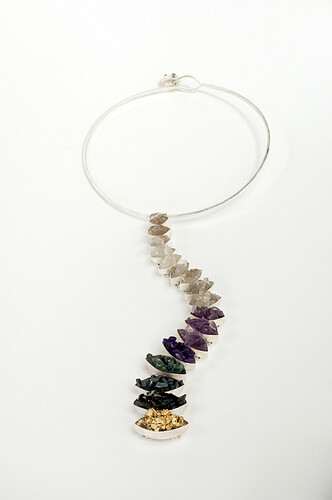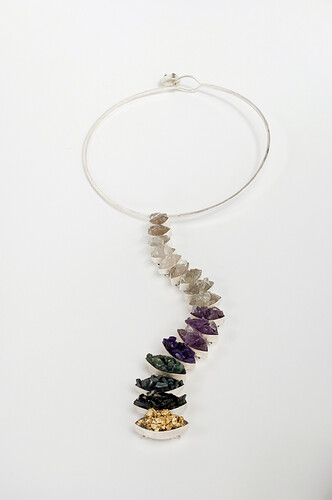Materials: sterling silver, white quartz, clear quartz, amethyst, green amethyst, onyx, jasper, gold leaf
Dimensions: 13.5" x 1/4" x 1.5"
This extravagant neckpiece is made of crushed semi-precious stones and crystals, set in sterling silver bezels that taper down the chest with gold leaf accents.
Photo credit: Vaccarro Photography Services
Gabrielle Nicole Morris
Gabrielle Nicole Designs
New York, New York. USA
Gabrielle Nicole was born in the small town of Montgomery, New Jersey where she grew up to realize her dream of becoming a jewelry designer. Her love of jewelry design started at a young age when she began making pieces on the sidelines of her brother’s little league baseball games, and flourished into a deep passion and career. She successfully earned her BFA in jewelry design at Pratt Institute in Brooklyn, New York, and has taken classes at Fashion Institute of Technology, Rhode Island School of Design, and Tyler School of Art. She has worked with leading designers in the industry such as Alexis Bittar, Pamela Love, and Lulu Frost.
In addition to working with sterling silver and gemstones Gabrielle enjoys exploring the use of alternative materials such as leather, fabrics, resin, and acrylics. Gabrielle’s statement pieces are inspired by her travels around the globe and the allure of high fashion, as she continues to live and work in New York City.
The exhibition explores metal works whose primary theme is color embraced as their primary visual focus, whether that be using colored materials, exploring creating colored surfaces, or encasing the object in color.
As the world's largest jewelry related internet site, Ganoksin strives to develop exhibitions showcasing work from around the world. This exhibition was open to all metalsmiths, professional and amateur, advanced and beginner.
In total 303 artists contributed 814 show pieces for the permanent online exhibition.
The exhibition was curated by Beth Wicker, President of the North Carolina Society of Goldsmiths in the United States, and Adjunct Instructor at Northeastern Technical College in South Carolina. Director of the exhibition is Hanuman Aspler, founder of The Ganoksin Project, the world's largest internet jewelry site.
Hue is one of the primary properties of color, it refers to the place the color occupies on the visual spectrum. Humans have used hues throughout time, to create cave paintings, to decorate themselves, their clothing and their housing.
Different hues have taken on different meanings throughout time. Gold traditionally has been a color of purity - the metal gold is relatively unchangeable, and the hue of gold has come to stand for gods and goddesses, for royalty, for durability and for purity. Red has often meant love, or passion. Hues often reflect the meaning of the seasons, with pastels referring to spring and the burst of new life after the pale hues of winter. Summer is reflected in vibrant, deep hues, followed by the browning of hues in the fall as plants go to seed and die, and the land turns fallow.
The worth of a hue has often been tied to what is necessary to make the pigment that creates the hue, and the expensive involved in the process. Often created from crushed stones that had to be mined and carried by caravan over thousands of miles, or from fermented roots of plants only grown in certain areas, or the carapaces of rare insects - the creation of hue in a way that could be used by man was an involved and generally expensive process.
In today's world metalsmiths have access to perhaps the widest range of materials and hues in the history of man - and in some of the most affordable ways ever.
This exhibition celebrates hue - color - as an integral, inherent element of the work. We talk of the "richness" of color, and examples of this abound here. One expects hues from the colors of gemstones used in metalsmithing, but we also have hues from some less expected places. Glass enamels are an ancient way of adding color, as are a variety of patinas. Today's artists also use synthetic man-made materials to add color in ways that didn't exist a century ago.
We invite you to enjoy this celebration of hue, and the ways hues and their use have changed over time.

